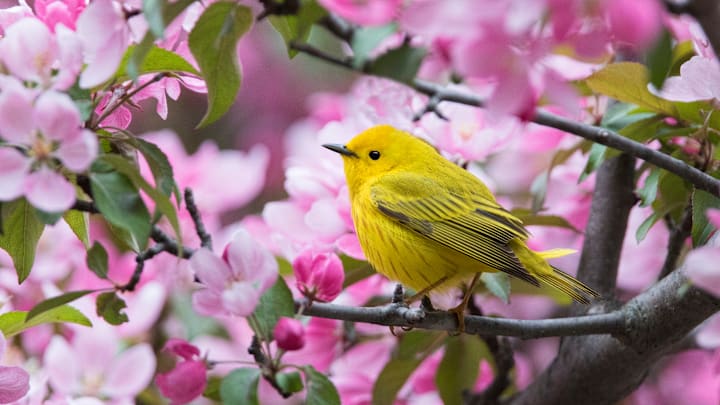Nothing ruins the joy of watching backyard wildlife like the sudden thunk of a bird smashing into your window. A streak-free shine might delight human eyes, but it can be deadly for birds; to protect your avian neighbors from a potentially lethal crash, you need to distort the reflective glass they often mistake for another patch of their habitat. Here are some ways you can help prevent birds from striking your windows. (And if you do encounter a victim of a window strike, be sure to contact a local wildlife rehabber for advice or assistance. Do not attempt to rehabilitate an injured animal on your own.)
1. Apply tape to the outside of your windows.
Applying strips of tape in a tightly spaced grid across the exteriors of your windows will distort any reflection on the glass. Though the rows of tape may slightly obstruct your own view of the outdoors, creating large gaps between the strips defeats their purpose, as birds accustomed to darting among dense branches may still attempt to squeeze through the non-reflective portions of the window.
2. Hang “zen curtains” in front of your windows.
Acopian BirdSavers, also called Zen Curtains, dangle outside your windows and function much like tape would, although they’re a bit more visually appealing and don't involve sticking anything to the glass itself. You can make your own or buy premade BirdSavers.
3. Cover your window with decals.
Pick a theme, or assemble an eclectic collection of decals to stick to your windows. Either way, you’ll need to use a fair amount; to effectively deter birds from smashing into the glass, you need to ensure there isn’t a lot of space between the stickers. Audubon advises leaving a gap no larger than 2 to 4 inches between each decal.
4. Use tempera paint or soap on your windows.

Here’s an idea kids and kids-at-heart will enjoy: Grab some tempera paint or a wet bar of soap and unleash your inner artist. You can create elaborate scenes or merely scribble to your heart’s delight—again, ensuring there isn’t a lot of space between each design. Tempera paint is pretty durable and won’t wash off during a summer storm, though you’ll easily be able to erase your artwork with a sponge or wet cloth [PDF].
5. Move your houseplants away from your windows.
A bird searching for a new perch may not notice the layer of glass guarding your indoor plants. Moving houseplants away from a window could help prevent accidental mid-flight crashes for birds who set out to investigate a new patch of flora.
6. Install screens or netting on the outside of your windows.

Not only can screens and nets catch pesky insects, they also add a murky layer in front of the reflected landscape scenes that often draw birds to glass. For insect screens, make sure they’re outside the windows and cover the entire section; for netting, the net should be taut and at least 3 inches from the windows so that birds can bounce off the soft barrier before crashing into the glass.
7. Cover your windows.
To fully obscure any reflective glass and prevent accidental bird strikes, draw your curtains shut or close your blinds. You don’t need to turn your house into a cave-like abode and sit in the dark all day—simply shield the windows of whatever rooms you aren’t using. As a bonus, covering your windows on a hot summer day will help keep your house cool.
8. Turn your lights off at night

Every spring and fall, billions of birds migrate great distances at night. For some, that long journey ends with a catastrophic crash into a brightly lit window.
Light pollution disorients the migrants, as many of them navigate by starlight. The confusion can cause them to collide with windows, and also leaves surviving birds exhausted as they try to navigate the confusing, artificially bright skyscape. To help migrating birds reach their destination safely, turn off or dim internal and external lights.
This article originally ran in 2021; it has been updated for 2022.
